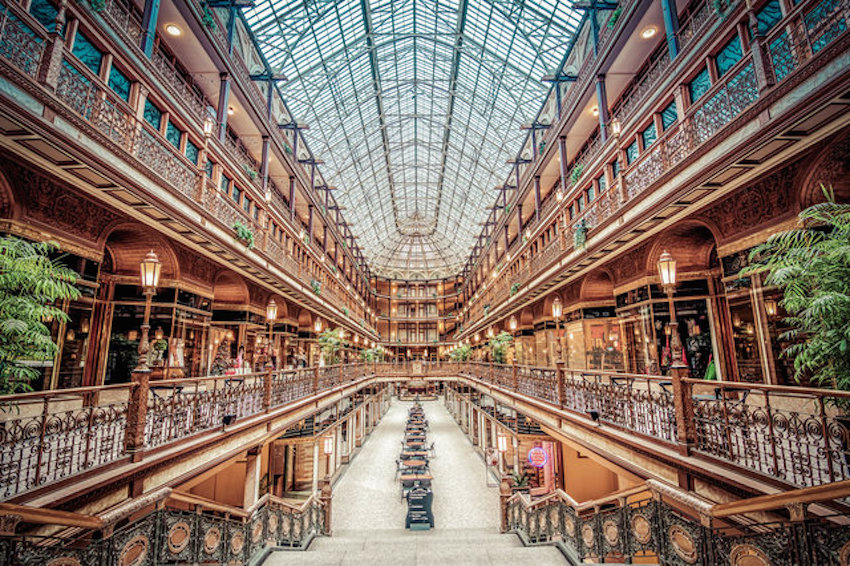Walk down any street in Downtown Cleveland and you’ll know the city had history. The bricks and stones, the gargoyles and Corinthian columns: they’ve played host to millionaires and mobsters both. The tycoons have cleared out of Millionaires’ Row, and the mafia is (mostly) closed for business these days. Yet we should keep in mind the words of Alexandra Lange in her essay “How to Be an Architecture Critic“: “Owners, clients, and residents come and go, but architecture lives on, acting a role in the life of the city and its citizens long after the original players are gone.”
Fortunately, if buildings are a measure of life in the city, then Cleveland has livelihood to spare. Fodor’s recently recognized the city’s “distinctive architecture” in a list of reasons to visit Cleveland now. Nice as the mention was, the list hardly scratched the surface of what the city has to offer: the East Side gives us the historic Tudor homes of Shaker and Cleveland Heights and the monuments of Lake View Cemetery. The West Side gives us its namesake market and the distinctive spires of old-world churches like St. Theodosius. The city is rich with outdoor art, and older landmarks like Tower City and the Guardians of Transportation have become unofficial mascots of the city’s revival. (Plus, LeBron’s back.)
What follows is an incomplete and totally biased list of the best architecture in the city. It attempts to bring together the old and new, what has lasted and what may last yet.
Sad to say it’s been a little quiet there since its 2001 re-opening, but businesses are moving fast to rent out the last unused spaces. Soon, we hope, The Arcade will take its rightful place alongside the neighboring East Fourth Corridor as one of Cleveland’s most bustling shopping and dining destinations. And dear reader, you can be the one to make it happen. Stop by in December for one of the best Christmas displays in the entire city.
From our partners:
The Mall

It’s not huge, as far as urban parks go. Its design is unassuming: segments of well-kept grass separated by concrete walkways and a couple main streets. It’s peaceful enough that you’d hardly know you’re standing on top of the new Convention Center. The center didn’t alter the skyline, but its construction did elevate a section of the mall. Take advantage by jogging up the wide stairs Rocky-style to take in the lake, the Rock Hall, and our hometown Factory of Sadness.
Turn around for one of the best ground views in all of Downtown: the soaring figure of the Fountain of Eternal Life, framed perfectly between the Cleveland Public Library and the Howard M. Metzenbaum U.S. Courthouse. With Public Square re-opening this summer, let’s hope Cleveland keeps adding more green spaces Downtown to match all the ones just outside of it.
The Cleveland Trust rotunda
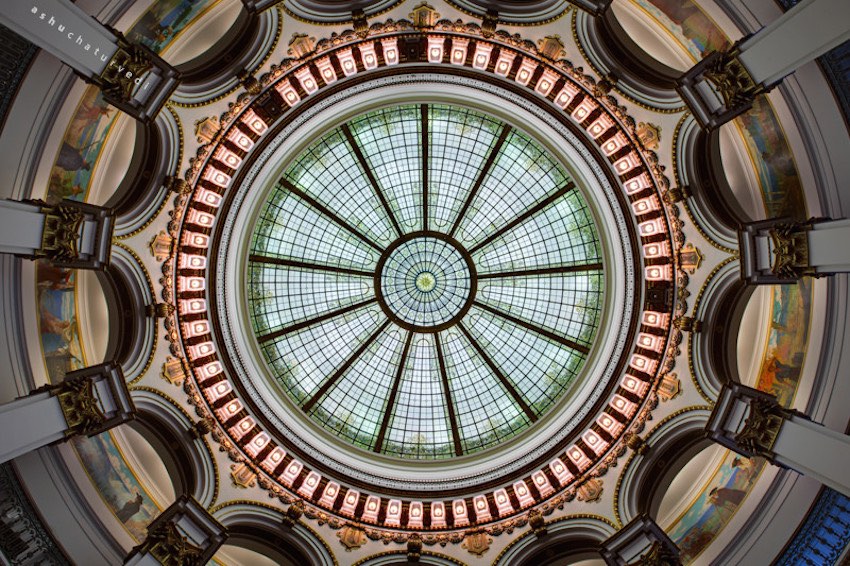
Completed in 1908 by George Post
When high-end local grocer Heinen’s announced it was opening a Downtown location in 2015, it was heralded as a sure sign of Cleveland’s resurgence. Yet the most exciting part was where it was to be put: the lobby of the old Ameritrust Bank. It’s a building for which “awe-inspiring” is not hyperbolic. The ceiling is a dome made with Tiffany-style glass that would not be out of place in the world’s great churches and cathedrals.
Beneath the dome is a wall-to-wall series of murals depicting the settlement of the Midwest painted by Francis Millet, who would later die onboard the Titanic. The bank’s marble teller counters have been repurposed as tables on the second floor, so you can enjoy your Heinen’s sushi or beer sample on a piece of Cleveland history.
If you venture below Heinen’s, you’ll find Vault, a nightclub that has wisely preserved Ameritrust’s elaborate and beautifully designed vault doors. Check it out if you have $300 to blow on bottle service. Or if, like your correspondent, nightclubs give you a case of the howling fantods, sneak down in the afternoon when it’s open but empty.
Cleveland Public Library: Main Branch and Louis Stokes Wing

Main Branch completed in 1925 by Walker & Weeks; Louis Stokes Wing completed in 1997 by Hardy Holzman Pfeiffer Associates
The next time some East Coast dude tries to patronize you about living in Cleveland, find a way to casually mention that outside New York and the Library of Congress, our city has the largest public library in the country. Then you should go to that library.
Called “the People’s University,” it’s really more like a temple. Striking Corinthian columns out front, Italian Renaissance-style marble staircases within, the space is so hushed and grand that each new room you walk into is like entering the ballroom from Beauty and the Beast. It’s no wonder the main branch was chosen to host a copy of Shakespeare’s First Folio when it comes to Ohio this June.
The Louis Stokes Wing’s façade features an innovative mixture of glass and marble that still looks innovative nearly 20 years on. The wings are connected by the Eastman Reading Garden, an idyllic outdoor reading spot right in the middle of the city. Take your book out there when it re-opens this summer (and see how many statues of those little Smurf-like dudes you can find).
While you’re out there, take pride in knowing that Cleveland’s library system was among the first in the nation to actually open its stacks up to the patrons for browsing, a quantum leap forward in public access to books and knowledge. Power to the people, and glory to the People’s University.
Tinkham Veale University Center — Case Western Reserve University
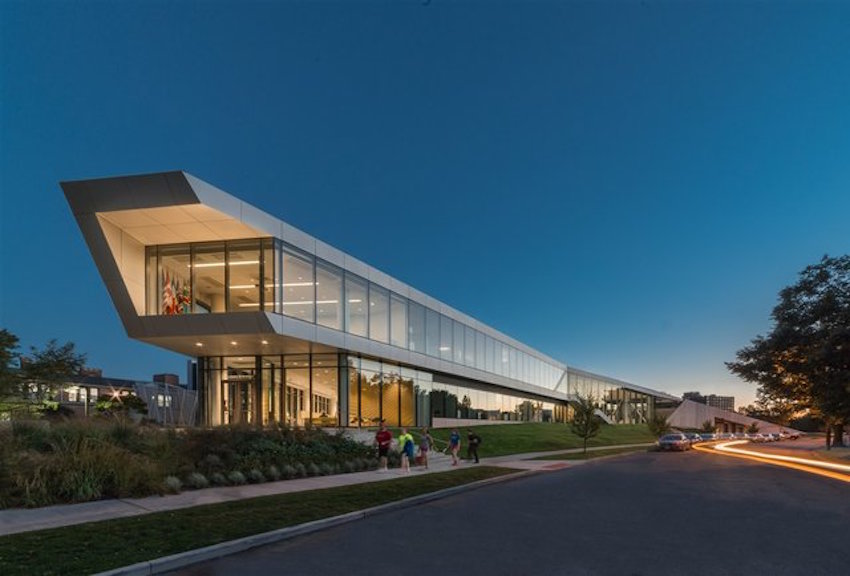
Completed in 2014 by Perkins + Will
When we talk about architecture, there’s a danger in waxing rhapsodic over the newness of buildings. The cities and universities of America are filled with buildings that excite crowds when they open but reveal themselves over time — sometimes just a few years later — as triumphs of style over substance. It’s possible that in 10 years, the Tinkham Veale will reveal itself as one such building. But we doubt it.
Affectionately dubbed “the Tink,” Case Western’s new student center defies traditional building shapes. Let’s call it a three-winged, multi-tiered polygon of glass and grass. No, not that kind — the grass covering the “vegetative green roof” helped it receive LEED Gold Status from the US Green Building Council. Everything in the Tink feels wide open — even the chairs — sturdy and comfy, great for studying — have backs that go up forever. The panoramic glass walls let in plenty of natural light for the 10 days of the year that it’s sunny in Cleveland.
The Grand Ballroom, nearly 8,000sqft, has in the past year alone hosted the likes of Gone Girl author Gillian Flynn, contemporary fantasy icon Neil Gaiman, and podcast titan Sarah Koenig. Be sure to sit on the outdoor balconies to take in the rest of the campus’ impressively eclectic architecture — the Peter B. Lewis building, Case’s flirtation with Arthur C. Clarke-ish futurism, and designed by famed architect Frank Gehry, lies just northeast of the Tink.
The Ames Family Atrium — Cleveland Museum of Art
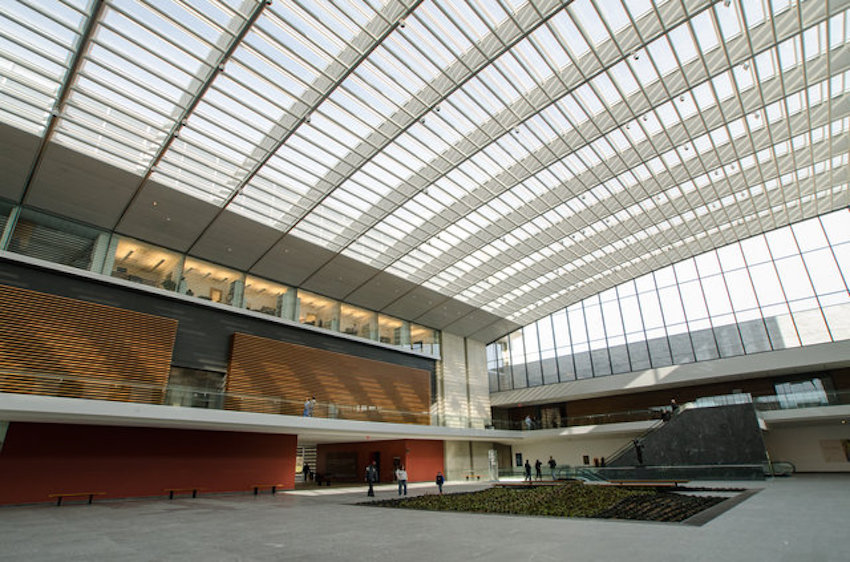
Completed in 2012 by Rafael Viñoly
Take a drive from Downtown to the Cleveland Museum of Art. Go through the Cultural Gardens on MLK, one of the greenest, most scenic drives in the city. Park south of the museum to walk through the Fine Arts Garden (designed by the firm of Frederick Law Olmsted, the man behind Central Park) and head up the steps past one of the last Auguste Rodin-supervised casts of The Thinker (be sure to note where the iconic statue’s feet got blown off in an unsolved 1970 bombing). But don’t enter that way.
Walk around to the Breuer building, the museum’s north wing. That way, the Atrium will be one of the first things you see. The Atrium is over 31,000sqft of marble, glass, and open air. The glass ceiling — to call it “soaring,” at three stories, doesn’t feel like an exaggeration — coupled with indoor garden planters on the east and west sides, make for an unparalleled feeling of being outdoors while indoors. Entering from the north will let you appreciate the full white marble facade of CMA’s original 1916 building. Then, look behind you for the horizontal wooden slats that help buffer noise and echoes while replicating the striped marble of the Breuer wing that has becomes CMA’s signature (and incorporated into its logo).
A breathtaking combination of classic and contemporary design, the Atrium also holds Provenance, a restaurant and cafe from award-winning Cleveland chef Douglas Katz, rotating art installations, and events like the Solstice, which brings musicians from all over the world to perform in Cleveland.
The Allen Theatre
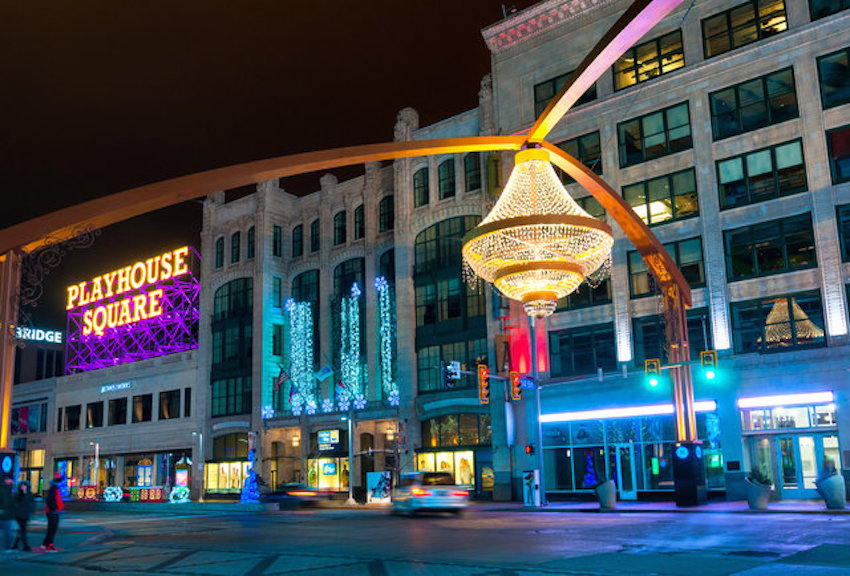
Completed in 1921 by C. Howard Crane
Cleveland Play House, the regional theater company currently performing in the Allen Theatre, recently celebrated its 100th anniversary. It was a big enough deal that NPR did a segment on the celebrations on All Things Considered. And good on them to take note: CPH is a formidable and criminally underrated force in American theater, and Playhouse Square, the stretch of Euclid Avenue it calls home, is the largest performing arts center in the nation outside New York (howdaya like them apples, Chicago?).
We could have picked any of the Playhouse Square theaters for this list — a special shout-out to the recently renovated State Theatre — but the Allen Theatre won us over for its history as well as its appearance. It started its life as a grand silent movie theater with over 3,000 seats. It re-opened in the late ’90s to host grand Broadway productions, then re-re-invented itself in 2011 as a home to two small, intimate theaters, the Helen Rosenfeld Lewis Bialosky Lab Theatre, and the Outcalt Theatre.
Dressed in wine-and-gold (go Cavs!), the Reinberger Rotunda is a near-exact replica of the inside of the Villa Madama, a Renaissance-era rural home in Italy. Sixteen Corinthian columns lead your eyes upward to a ceiling adorned with — what else would you expect from Italian art? — mythical Roman creatures and half-naked ladies with robes and vases.
Be sure to practice your dramatic line delivery while standing there — the rotunda gives all who speak inside it a pleasing and reverberating echo. Here’s to another 100 years of great CPH theater at the Allen.
This feature originally appeared in Thrillist.







